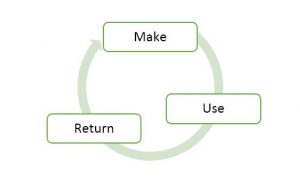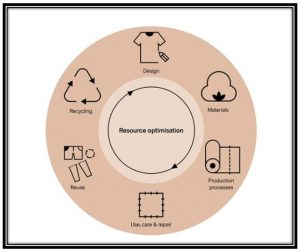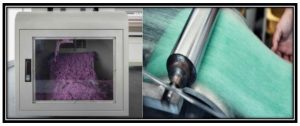What is Circular Economy?
Circular Economy is an economic system founded on the reality that resources are finite. A circular economic system aspires to minimize the use of resource inputs and designs out wastes at all stages of production and use of the product. It is a closed-loop system in that it reintegrates the product back at end of use (instead of discarding it) thereby extending its usage life for as long as possible.
This novel system takes sustainability and the climate crisis seriously, and envisions a holistic circular economy which is vital to reducing negative impact to the environment while addressing future competitiveness.
LINEAR ECONOMY vs CIRCULAR ECONOMY
A Circular Economic Model diverges from a Linear Economic Model. CNBC presents the example of a light bulb to illustrate the difference between the two.
A Linear Economy follows the Take-Make-Dispose process. In a Linear Economy, a lightbulb company uses or takes materials like glass or metal to manufacture its products. The company makes the product and sells it to its customer. The customer uses the product and disposes it when it has burned out.

To earn profit, the lightbulb company buys materials at the lowest cost possible and sells as many bulbs as possible. One may notice that in the Linear Economic Model, resources are assumed to be infinite.
In sharp contrast, Circular Economic Model treats materials like they are finite. Going back to the light bulb example, in a Circular Economic Model, a company does not just recycle products but maintains ownership all along. The producer has evolved from just being a manufacturer of a product to be a kind of service provider. After making the product, the user (uses) leases lights from the manufacturer, signs a contract for the lease period- including maintenance and replacements at no extra cost. The user did not dispose the burned-out light bulb and buys another to replace it but was returned to the manufacturer.

Circular Economy in the Fashion Industry
This model could also be adopted by businesses in other industries. For instance, H&M (Hennes and Mauritz), a Swedish clothes manufacturer and one of the biggest in the garments industry, redesigned their product development life cycle and changed their entire value chain using the circular economy approach.
H&M implemented a circular mindset from designing products and packaging, to enabling their customers to care for and part with their products. They offer in-store garment collection and recycles them. They have also started their Take Care Initiative which offers guidance and services on how to prolong the life of their clothes.

H&M has also introduced clothes rental and pre-owned options, and invested in fabric recycling and innovative low impact materials. Since 2013, H&M has gathered more than 55,000 tons of fabric to reuse as new garments.

Here, customers bring a garment they don’t want which will be cleaned, disassembled, shred into fibers, turned into a yarn, and then reused to create new items: a scarf, a baby blanket or a sweater- for a fee of $11 to $16. The process takes about five (5) hours and is visible to shoppers.

H&M’s Looop system is at its infancy stage. CNN reports that as of October 2020, Looop is only available in Sweden and that it lacks the scale to create an impact in the reduction of textile waste- which was about 16.9 million tons in 2017 in the United States alone.
Considering the enormous “over consumption” in the clothing industry, other fast fashion companies are also adopting the circular model. In 2019, Zara announced that customers can likewise drop off used clothing, footwear and accessories in their stores; and that in 2025, all of the cotton, linen and polyester used by the company will be organic, sustainably-sourced or recycled.
Restructuring the Value Chain
The circular business model has spawned new entrants in the value chain to give new life to fabric waste.
Jessica Schreiber, former employee at the New York City Department of Sanitation, and was in charge of the city’s clothing recycling program, founded Fabscrap. Fabscrap is a non-profit organization based in Brooklyn that recovers, redistributes, and recycles excess textiles. They work with about 500 brands and couture in New York City including J. Crews, Express, Carolina Herrera, Marc Jacobs, among others, to reduce their fabric waste. They collect about 8,000 pounds of sample garments and swatches of fabric per week which would have otherwise gone to landfills or incinerators. They then sort these items for reuse, resale or for recycling. About a third to a half of the collected scraps go to their shredding partner in New Jersey, which then use the shredded material as carpet padding or mattress stuffing. The bigger pieces, meanwhile, were redistributed and made available for fashion students, crafters, or quilters.
In 2015, the European Union has adopted a plan to make supply chains more circular. This is not just to resort to greener production and reap its environmental benefits, but to gain an estimated 12% increase in GDP by 2050.
In ASEAN, Thailand is leading the adoption of circular economy model. Recently, the Thailand Chamber of Commerce and its network of about 100,000 companies have expressed their intention to commit to operating their businesses in a more sustainable manner. This is part of the Thai Government’s Bio-Circular-Green (BCG) Economy Model thrust.
Disclaimer: The views expressed herein or in any article in the UP ISSI website are those of the authors and do not necessarily reflect the policies or opinions of UP ISSI nor the views of the University of the Philippines. Regarding Accuracy of Information and Usage of Data: Visitors and users of the UP ISSI website are advised that information contained within the website is assumed to be accurate. However, errors can occur even with computer-generated information. UP ISSI makes no representation regarding the completeness, accuracy, or timeliness of such information and data, or that such information and data will be error-free. Visitors are encouraged to review the official version of all documents on which they plan to rely on.